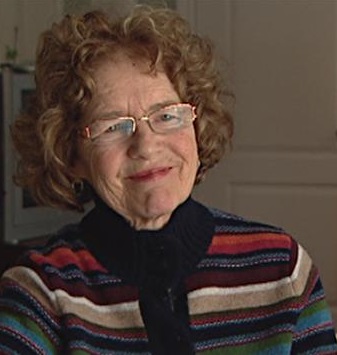2020-02-09: Webinar on Bill 21 For Humanist Canada
Posted By jean.meslier On 2020-02-21 @ 11:56 In | No Comments
Quebec Bill 21: A modest but historic step forward for secularism
Webinar for Humanist Canada, 2020-02-09
David Rand, President LPA-AFT and Spokesperson RPL
2020-02-24
The following is the text of a webinar presentation done by the author for Humanist Canada on February 9th 2020. The section intertitles refer to slides in the corresponding slide presentation [1].
Please open the slide presentation [1] and refer to it as you read through the text below.
The sections/slides entitled “Intersectionality,” “RPL Coalition” and “Attitudes towards religious symbols & accommodation in Quebec” were not covered in the Feb. 9th presentation because of lack of time.
The video of this presentation [2] is also available in our Youtube channel [3] playlists.
SLIDE: “Quebec Bill 21: A modest but historic step forward for secularism”
Bill 21, Loi sur la laïcité de l’État, is a law adopted by the Quebec National Assembly on June 16th 2019 with the purpose of implementing State secularism in that province. Before discussing this particular legislation, we need to define secularism.
SLIDE: “What is Secularism?”
Secularism may be defined as consisting of four principles:
- Equality, i.e. equality of treatment for all.
- Freedom of conscience, including freedom of religion and freedom from religion, as well as other freedoms.
- Religious neutrality, i.e. State neutrality towards religions.
- Separation, i.e. separation between religions and State.
The first principle, Equality, includes equality between women and men, of course.
SLIDE: “Freedom of conscience”
In the second principle, Freedom of conscience, freedom of religion is often included explicitly. I disagree with this, because freedom of conscience already includes it. Mentioning freedom of religion—without explicitly mentioning freedom from religion as well—gives undeserved priority to religion.
SLIDE: “Religious Neutrality”
The third principle, Religious neutrality, if used in isolation, is an ambiguous expression because it has two very different interpretations, one of which does not even consider non-believers, as if atheists did not exist or were of no consequence. Those two interpretations are:
- Neutrality among religions, i.e. all religious belief systems, excluding non-religion or non-belief.
- Neutrality among all convictions, whether religious or non-religious, belief or non-belief.
The difference is that the first excludes non-believers from consideration whereas the second includes them. In the version of “secularism” proposed by John Locke, for example, the first interpretation applies.
The fourth principle, Separation, means that the State must be independent of, and autonomous with respect to, all religious institutions and belief systems. This is necessary because religion is dangerous whenever it interferes with government and State, that is, whenever it has political aspirations. This principle is absolutely critical because without it, the third principle degenerates into the version of neutrality restricted to religious believers only. Furthermore, without separation, the first two principles are also compromised. The equality principle is compromised because atheists are not given equal treatment and because religions in general are often very misogynistic, thus threatening equality between women and men. Freedom of conscience of not only atheists but everyone, including believers, is also threatened by religious influences in the State.
SLIDE: “The Three Spaces”
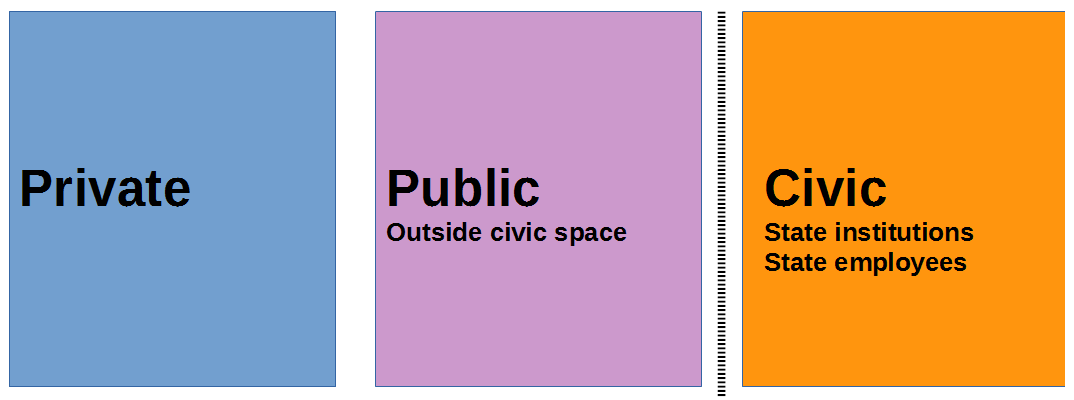
For the purposes of secularism, society can be modelled by dividing it into three spaces, three areas of endeavour:
- Civic space, i.e. State institutions such as legislatures, government buildings and offices where public services are provided, public schools, etc.
- Public space which is not civic, i.e. all other public spaces.
- Private space.
It is in civic space that separation between religions and State must apply, i.e. civic spaces must be free of religious influence. This applies to physical installations and State employees, but not to users. The lines between spaces are not always physical: for example, for services provided to the public by civil servants, the latter are State employees and they are of course in civic space, but the users are not in civic space.
The language is sometimes ambiguous: e.g. the expression “public services” refers to civic space.
SLIDE: “Consequences of Separation”
The separation principle is critical for secularism and has a number of implications:
- Religious beliefs and practices are not sacred. Religions are no more sacred or respectable than any other ideology such as Marxism, free-market capitalism, or Pastafarianism. All are subject to examination, criticism, ridicule.
- The State does not respect religious beliefs or practices. Rather, it respects citizen’s right to practice their religion in the private and public spheres, but not the civic.
- The State is blind to the religious affiliation of the individual. It treats all citizens equally without regard to such specifics. This is called universalism.
- Religious believers are responsible for their beliefs and practices, not the State.
(Multiculturalist ideology takes the opposite position: that the State is responsible and must accommodate religious practices.) - Religious accommodations by the State are never acceptable.
Examples of religious accommodation:
- To allow police to wear crucifixes or hijabs or Pastafarian colanders while on duty is to grant religious privileges while violating the separation principle. It amounts to religious interference in State affairs.
- Motion M-103 which condemns so-called “Islamophobia” which is simply blasphemy against Islam, thus granting special protection to one specific religion.
- Allowing Sikh members of the RCMP to wear headgear different from the uniform.
SLIDE: “First Amendment”
The First Amendment of the U.S. Constitution is an important example of the failure to separate religions from the State. Here is the beginning of the First Amendment, the only part which mentions religion:
Congress shall make no law respecting an establishment of religion, or prohibiting the free exercise thereof…
As Shadia B. Drury has pointed out (in Free Inquiry, vol 32, #3), “The establishment clause is not an endorsement of secularism but of nonsectarianism.” What Drury calls nonsectarianism, I would call religious neutrality. It means that the State favours no one religion over others and that there is no state religion. Thomas Jefferson famously used the phrase “wall of separation” in a commentary he made, the Letter to the Danbury Connecticut Baptist Association. However, there is no mention of separation between religion and State in that Amendment, or to the best of my knowledge, anywhere else in the US Constitution. Some court decisions in the US have fortunately endorsed some degree of separation, but that principle is absent from the First Amendment.
Even worse, the First Amendment appears to accord unlimited scope to freedom of religion, implying that it can never be abridged by other considerations, such as other people’s rights. (As we shall discuss later, one person’s rights end, or should end, where other’s rights begin.)
The Canadian Constitution, although much younger (adopted in 1982, without the approval of Quebec by the way) is much worse. It does not even declare religious neutrality, but declares that one of Canada’s founding principles is the “supremacy of God” no less! Again, Canadian jurisprudence, like the American, is better than the corresponding constitution: the 2015 decision of the Supreme Court of Canada in the case of the MLQ vs. Saguenay, fortunately downplayed the importance of that “supremacy of God” phrase, but it remains on the books and may cause problems in future.
The American model of so-called “secularism” as expressed in the First Amendment is not secularism but rather 18th century pre-secularism. This was certainly progressive for the time, when Europe was full of monarchies and various degrees of theocracy. Americans can be proud of that. But they, and we, must stop looking to the US Constitution as a model to emulate, because we can do much better, and some jurisdictions have already have, such as France, Mexico and Quebec.
Furthermore, if the American model is falsely vaunted as superior, the result is to impede secularism by holding it back to an outdated version. This is precisely what is happening in reaction to efforts by Quebec to apply secular measures in that province.
SLIDE: “Bill 21, What It Does”
Please refer to Bill 21 in English [4] or Bill 21 in French [5].
- Bans religious symbols worn by public servants in positions of authority, i.e. basically police, judges, prosecutors, prison guards and public school teachers. (section 6)
- Bans face-coverings for employees providing civic services and users receiving such services. (section 8)
- Contains a simple, clear definition of secularism (as above). (section 2)
- Contains a simple, clear definition of “religious symbol.” (section 6)
- Bans religious accommodations. (section 14)
- Contains a “grandfather” clause, i.e. an exemption for employees who are in the same job as they were on March 27th (the day before publication of the draft bill). (section 31)
- Stipulates measures to monitor the application of the law and to respond to instances of noncompliance if any. (section 13)
- Adds the principle of State secularism to the Quebec Charter of Human Rights and Freedoms, thus giving it near-constitutional status. (sections 18, 19)
- Guarantees secular civil services and secular parliamentary, governmental and judicial institutions. (section 4)
SLIDE: “Bill 21, What It Does Not Do”
- Does not ban religious symbols for all public servants.
- Does not ban religious symbols for teachers in private schools and for workers in child-care centres.
- Does not ban religious symbols worn by MNAs (Members of National Assembly). This is inconsistent with removal of the crucifix from the legislature.
- Does not ban all religious symbols displayed as part of State buildings. (However that infamous crucifix in the Salon Bleu has been removed.) Furthermore, it contains a provision, added at the last minute, which prevents State secularism from being used to modify a State building, thus allowing religious symbols to remain!
- Does not remove monarchist symbols from the National Assembly.
- Does not deal with the significant fiscal privileges (tax exemptions, partial funding of private religious schools, etc.) which religious institutions enjoy.
- Neither cancels nor reforms the notorious Ethics and Religious Culture (ERC) program in Quebec schools, a compulsory course at all levels which indoctrinates children into a communitarianism and a sugar-coated view of religions. However, the Quebec government has since announced, only recently, that it will do a major revision of the ERC program, probably removing all religious content or greatly reducing it, and has undertaken public consultations on that reform.
- Does not impose secularism in the health care sector. More on that shortly.
Bill 21’s greatest weaknesses are (1) its failure to ban religious symbols for all civil servants and (2) its failure to address the question of the fiscal privileges which religion enjoy. The fiscal problem [6] stems mainly from the fact that Quebec accepts the federal definition of a charity which includes the advancement of religion as one of its criteria. This must stop.
SLIDE: “Bill 21, Modest but Historic”
- Bill 21 is moderate, in fact timid, and incomplete.
- Helps to protect freedom of conscience of users of civil services and students in public schools. The cost: a small and reasonable restriction on the behaviour of State employees while on duty. To allow them to wear religious symbols on the job would constitute religious accommodation.
- A small but important step towards slowing the spread of religious fundamentalism and fanaticism.
- Comparable to the Public Services Act [7] which imposes political neutrality on civil servants. In fact, that Act is much stricter than Bill 21, applying to the entire civil service and even applying partially when off the job.
- A question of professional ethics, like the Quebec Public Services Act.
- Disciplinary, not discriminatory. It targets behaviour, not people.
- Comparable to anti-tobacco legislation [8] which also targets behaviour, not people. Such laws are not discriminatory. Rather they are disciplinary. They ban smoking in specific locations and they apply to everyone. Anyone may still smoke elsewhere.
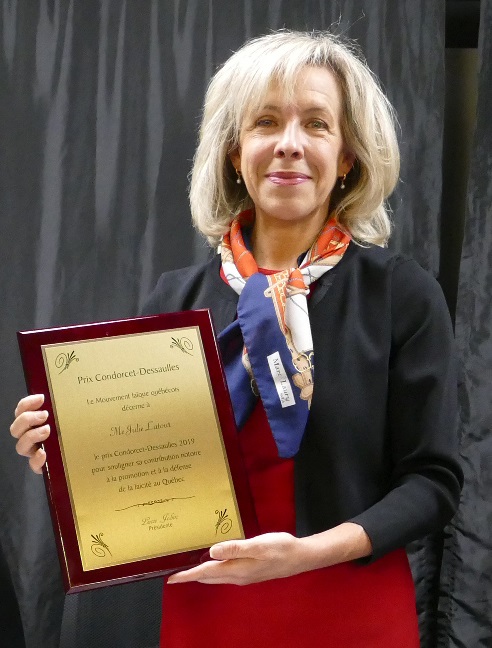
SLIDE: “Julie Latour”
Julie Latour is a lawyer and legal expert, former bâtonnière (2006-2007) of the Montreal Bar Association, Prix Concordet-Dessaulles 2019 (MLQ). In a recent article in Le Devoir [9], she explains the historic importance of this legislation:
“Bill 21 is first and foremost a generator of rights. All Quebec citizens benefit henceforth from a fundamental right to secular parliamentary, governmental and judicial services as well as secular public services. A major step forward, which benefits everyone, without dividing lines.”
SLIDE: “Bill 21: Who Will Benefit?”
Everyone will benefit from a civil service with fewer religious symbols worn by employees, especially in schools.
The greatest benefit will be to daughters of piously religious parents, especially Muslim parents, because it will allow them a reprieve from the religious environment of family and community. They will meet women who do not wear any religious symbol, including Muslim women who do not wear the veil. Of course all children, including boys, will benefit. But female children are most vulnerable to religious indoctrination because of the misogyny of religions, especially the three Abrahamic monotheisms.
This is what public education and universal schooling are for, to allow children to transcend the limited experience of their immediate surroundings.
Bill 21 should also help reduce the probability of acts of violence against religious minorities (in direct contradiction to what its opponents claim).
SLIDE: “Andréa Richard”

Andréa Richard is a former nun and author of Femme après le cloître (Woman After the Cloister). She is also recipient (along with Nadia El Mabrouk) of the MLQ’s Prix Concordet-Dessaulles in 2018. In a brief she presented to the Quebec National Assembly, Mme Richard argues eloquently for extending secularism to hospitals [10], while underlining the importance of what Bill 21 has begun:
“In a hospital, patients who, more often than not, are vulnerable, should not have to suffer discomfort caused by the very caregivers whose purpose is to care for them. […] Imagine a dying man who, in his youth, was raped by a pedophile priest and who is confronted by the sight of a priest, wearing a Roman collar and crucifix, who arrives at his bedside to ask if he would like the last sacraments. The patient would certainly be ill at ease, or worse… Imagine a Muslim woman, hospitalized because she was beaten by her father for refusing to wear the veil, who sees a veiled female nurse or doctor arrive at her bedside to care for her. What do you think her reaction would be?”
“To claim that an employee of the State who refuses to remove her ostentatious religious symbol is being denied employment is totally incongruous, because it is she who excludes herself by choosing her religion over her profession.”
“Tolerance is an admirable quality, but to tolerate the intolerable can easily become an abdication of responsibility.”
SLIDE: “Udo Schuklenk”
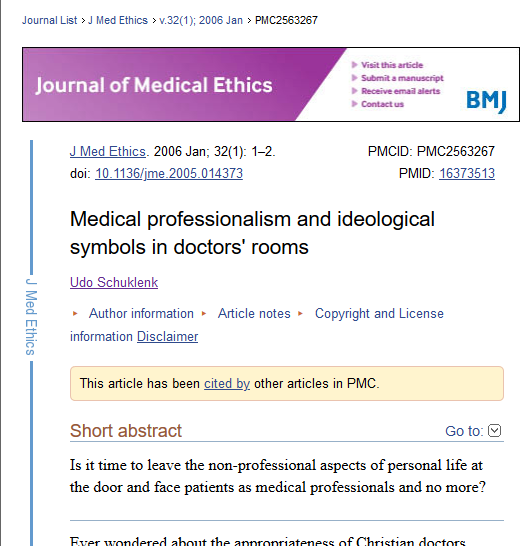
Writing in the Journal of Medical Ethics in 2006 [11], Udo Schuklenk echos Andréa Richard”s concerns:
“Is it time to leave the non-professional aspects of personal life at the door and face patients as medical professionals and no more?”
“professionalism […] requires the professional to act in an impartial, unbiased manner. […] health care professionals should refrain from displaying symbols in their offices advising patients of the professionals’ private lives’ religious, party political, sexual, or other affiliations.”
SLIDE: “Balancing Conflicting Rights”
Managing sets of conflicting rights is the rule, not the exception. There are countless examples of laws which seek an equilibrium.
- Abortion: Life of the fœtus (which is not a person but would become one if left to term) versus the right of the pregnant woman to control her own body and reproduction.
Compromise: Legal abortion, but criminalization of infanticide. - Mandatory Schooling: Parents have a right to raise their children as they see fit, while passing their values and practices on to them. But children have a right a quality education, free of indoctrination.
Compromise: Obligatory schooling for children up to a certain age. - Age of Consent: We deliberately deny sexual freedom to children, and for good reason. Age of consent laws specify that children under a certain age cannot consent to sex, thus protecting them from adult predators.
- Partisan Political Behaviour by Public Servants: In Quebec, the Public Services Act [7] bans partisan political behaviour for civil servants on the job, and even, to some extent, off the job.
- Traffic Regulation: Traffic regulations restrict freedom of movement, for reasons of safety and security.
- Gun Control: Right to self-defence versus public safety (firearms may cause more violence than they prevent).
Compromise: Gun registration, background checks, limited firepower, etc. - Tobacco Control: People have a right to smoke if they want. But second-hand smoke harms others and all tobacco smoke increases healthcare costs.
Compromise: Ban smoking in and close to most indoor public spaces. - Freedom of speech: Although extremely important, freedom of speech is not absolute. It does not include defamation or calls for gratuitous violence.
In general, one person’s rights end where another person’s rights begin. Just about any law you can think of implies some kind of restriction on someone’s freedom, but is justified because it protects the rights or security of others, or even of the same person. Good laws find a reasonable equilibrium between these two conflicting concerns, whereas bad laws draw the line in an inappropriate place. Most debates of public policy involve deciding where to draw that line.
Quebec Bill 21 is just another example of this very commonplace situation. The rights of an employee, such as a schoolteacher, bump up against the rights of his or her students. The students’ right to an educational environment free of religious advertising is clearly more important. The appropriate equilibrium, the appropriate place to draw the line is to ban the wearing of religious symbols by the employee while on the job. They retain full rights off the job.
SLIDE: “Misconceptions About Bill 21”
Opponents of Bill 21 tend to be unscrupulous and dishonest in the extreme, spreading several serious misconceptions about the legislation.
- No, Bill 21 does not discriminate against any religion.
- No, Bill 21 of course does not discriminate against women.
- No, Bill 21 does not tell women or anyone else what to wear. (Even if it did, dress codes are ubiquitous in society.) Rather, the law requires that State employees in some jobs respect professional ethics by presenting a religiously neutral appearance.
- No, Bill 21 does not diminish human rights. It extends rights to students and users of civil services and to the general citizenry.
- Accusations of “racism” thrown at Bill 21 and its supporters are particularly dishonest, slanderous and ridiculous. When the Public Services Act was adopted, were its authors accused of “racism” against Marxists and Friedmanites?
When someone says that Bill 21 is discriminatory (whether against a particular religion or against women) what does this means? It means either that the person is lying, or that the person holds the State responsible for everyone’s religious beliefs and practices. Thus if a State employee converts to Pastafarianism and starts wearing a colander on his or her head at all times, then the State would be obligated to accommodate that foible. Bill 21 rejects that silly idea.
SLIDE: “Leave your politics at the door when you go to work in the civil service.”

When religious symbols are worn by a State employee on duty, they become political, if they were not already so.
SLIDE: “Betraying the Enlightenment”
To understand the opposition to Bill 21 and to secularism, we must understand how much of the political left — or at least the most vocal part — has, in the 21st century degenerated severely, abandoning Enlightenment values — such as reason and science, constitutional government, religious tolerance, scepticism, separation of church and state, and the questioning of religious orthodoxy — and turning its back on secularism which the left has traditionally supported. Opposition to Bill 21 from religious fundamentalists, and in particular Islamists, is unsurprising and is of course to be expected. What makes the situation much more serious is that much of the left has allied itself, objectively at least, with political Islam in opposition to secularism.
This anti-Enlightenment pseudo-left is often called the “regressive left,” an expression attributed to British activist and broadcaster Maajid Nawaz, a former Islamist and now a prominent critic of Islamism, in order to describe ostensible leftists who basically give Islam and Islamism a free pass, holding them exempt from the criticism which would normally be directed at all religions. The mentality reflected by this political tendency is composed of a number of ideologies, in particular:
- Intersectionality, a theory of systems of social power which concentrates on the intersection of various forms of oppression among those who are members of several groups. It represents the death of feminism and anti-racism… and of any other previously progressive movement its infects.
- Islamoleftism, is a degenerate form of left-wing politics in which the priority which the left traditionally accorded to questions of class is now replaced by the defence of minorities, especially Muslims. For Islamoleftists, it is not enough to document and criticize the crimes committed by European colonialism and the slave-trade; rather, it uses these criticisms as a pretext to demonize European cultures and glorify Islam, as if Muslims (especially the most pious and vocal!) constituted the new working class (as in Marxist ideology) or the new elected people (as in Abrahamic mythology). It represents the death of the secular left.
- Multiculturalism, is a political ideology which attaches greater importance to ethnic or religious affiliation than it does to either universal rights or to citizenship. It represents the death of universalism.
- Postmodernism, a philosophy associated with cultural relativism and inspired by a scepticism about, or rejection of, modernist ideas of objectivity, rationalism, knowledge, etc. In its more radical forms, postmodernism involves the denial of even the existence of objective reality or objective truth and categorically rejects Enlightenment principles. It takes cultural relativism to an extreme, asserting that different cultures have different, socially constructed realities. It represents the death of objectivity.
The result is an irrational toxic soup in which there is nothing left left and in which minority religions, especially Islam, are granted impunity from criticism.
SLIDE: “Intersectionality”
Intersectionality is a theory of systems of social power which originated in the feminist movement. The basic idea is simple and superficially plausible: if an individual is a member of several groups which are targets of discrimination, then their degree of oppression increases with each group identity. For example, a black lesbian may suffer discrimination on the basis of race, sex and sexual orientation, whereas a white heterosexual women, on the contrary, is targeted only by misogyny. This view of oppression leads to a politics of division and guilt because in practice it reduces to a sort of point system in which the individual gains a merit point for each oppressed group in which she or he can claim membership. The result is a sort of caste system in which heterosexual cis-gendered white men, at the top of the heap, are demonized while those who win the most oppression points are celebrated and accorded immunity from all criticism. The goal of the intersectional activist is to upset or invert the heap, putting the point-winners on top. This view of the world is extremely simplistic as it sees each group as monolithic and homogeneous and it sees oppression as operating from the top down only.
Intersectional activists are obsessed with questions of privilege and view relations between groups as a zero-sum game in which someone must pay in order to end others’ oppression. They make endless moral judgments against privileged groups but tend to be short on real-world solutions because their theory is only very loosely connected to reality. Intersectional activists are notoriously blind to disparities or tensions within groups which may cause problems even greater than between-group disparities. They also tend to be very selective about the kinds of privileges they recognize. For example, they rarely if ever acknowledge religious privilege despite its ubiquity and its central importance in the fight for secularism. In the Canadian context, they are blind to the very real phenomenon of Anglo privilege.
Intersectionality reaches its most irrational and unreal in its attitude toward Muslims. As Muslims constitute a minority in the countries where this theory originated, they are considered an oppressed group. As a result, in order to fit the theory, any problems caused by a person’s Muslim identity must necessarily be caused by anti-Muslim prejudice and not by Islam itself. Hence, the non-sense term “Islamophobia” is validated and criticism of Islam becomes taboo and, of course, “Islamophobic.”
SLIDE: “The Great Canadian Euphemism”
Multiculturalism is the great Canadian euphemism. Perhaps it once meant cultural diversity, but not any more. It is now an ideology based on communitarianism — i.e. attaching greater priority to ethnic or religious affiliation and other personal identities, than to our common humanity — and religious determinism — the idea that a person is defined for life by an accident of birth, a prisoner of the religious community into which they were born. Multiculturalism is a sacred cow in Canada, part of Canadian mythology. As we, Atheist Freethinkers, declared in our brief submitted to a committee of the Quebec National Assembly in 2016, the cultural relativism inherent in multiculturalist ideology
“was obvious in the controversy about the niqab at Canadian citizenship ceremonies. Even worse, those who criticize multiculturalism are often the targets of defamation in the form of false accusations of racism or xenophobia,”
whereas in reality it is the multiculturalist ideology itself which is akin to a light version of ethnic or religious bigotry, because it is based on the assumption that members of certain ethnic or religious communities are incapable of adapting to modernity and must therefore be granted religious privileges. But these privileges come at a price: ghettoization, thus condemning them to cultural inertia and isolation.
Caroline Fourest, a French secular activist and author of several books, including In Praise of Blasphemy and an exposé of the ideology of Tariq Ramadan, has this to say:
The trouble with multiculturalism is not the fact of being multicultural—which is a reality of our lives, an obvious reality—nor is the problem cosmopolitanism or the melting pot. Indeed we would prefer more melting, more mixing together. The problem with multiculturalism is, in the final analysis, political patronage or clientelism that ends up valuing what differentiates us rather than what unites us, so much so that it even tolerates the intolerable. The old philosophical dilemma, that is to say that it ultimately tolerates—in the name of so-called diversity—religious fundamentalism, attacks on gender equality and sometimes even manifestations of racism and antisemitism. (Laïcité et tolérance [12])
Some examples of the consequences of multiculturalism:
- Endorsing child abuse by allowing and even celebrating the veiling of young girls.
- Noise blocking ear-pads for a child of Muslim parents in a Montreal school.
- Allowing religious group to hold prayers in Parliament building.
- The niqab in citizenship ceremonies [13]. Gerald Caplan’s obscene defamation of anyone who opposed it [14].
- Electoral clientelism
- Justin Trudeau’s slurring of secularists as Trumpers.
- Justin Trudeau’s failure to distinguish between homophobia and “Islamophobia.”
From the AFT press release [15]: Trudeau’s statement is “a semantic manipulation whose purpose is to prevent any criticism of Islam, in addition to being an insult to the dignity of homosexual persons. The result is also demeaning for Muslims as well. The Quran contains numerous passages which encourage violence and even murder and terrorism. Evidently, many Muslims, following their own personal judgment, reject these passages. To silence criticism of Islam would prevent these same Muslims from expressing opinions about their own religion. In addition, this censorious attitude risks provoking the hostility of those who seek to formulate legitimate criticisms of Islam, thus increasing already existing tensions. Furthermore, let us not forget that more moderate Muslims are subject to undue pressure from more radical Muslims and would thus be reduced to silence by such censorship.”
SLIDE: “Multiculturalism Rots Brains”
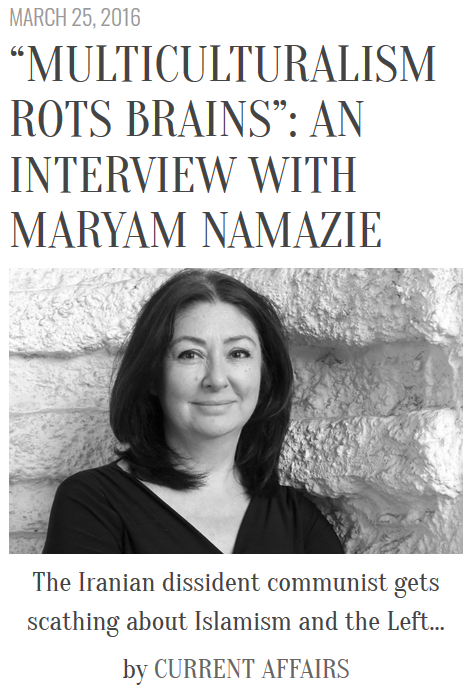
Maryam Namazie is a British secular feminist activist of Iranian origin and founder of the Council of Ex-Muslims of Britain [16]. Her take on so-called multiculturalism echos the words of AFT and Caroline Fourest: it leads to cultural relativism, ethnic or religious segregation and pandering to fundamentalist religion, including Islamism.
SLIDE: “Secularist Muslims”
As Maryam Namazie points out, we must not look at religious groups as monolithic — indeed, that is what multiculturalists do. Muslims are not one community and many dissent from the fundamentalist image that Islamists would like us to believe, and would like to impose on all Muslims.
Many Muslims or people from a Muslim background support secularism. Here are two examples:
- In Quebec, AQNAL, the Association québécoise des Nord-Africains pour la laïcité (Quebec Association of North-Africans for Secularism) is part of the RPL coalition in which AFT and several other groups participate.
- In France: a 2019 poll [17] found that 75% of French Muslims strongly support the 1905 secularism law. This is less than the figure of 87% for the general population, but it is still very high.
SLIDE: “RPL Coalition”
The Rassemblement pour la laïcité (RPL) or Alliance for Secularism is a coalition of several groups in Quebec which support secularism. It was founded in 2013 to support the Charter of Secularism of the PQ government of that time. We also support Bill 21 of course. The current participants are:
- Association québécoise des Nord-Africains pour la laïcité (AQNAL)
- Collectif citoyen pour l’égalité et la citoyenneté (CCIEL)
- Intellectuels pour la laïcité
- Laïcité capitale nationale (LCN)
- Libres penseurs athées—Atheist Freethinkers (LPA-AFT)
- Mouvement laïque québécois (MLQ)
- Mouvement national des Québécoises et des Québécois (MNQ)
- Pour les droits des femmes du Québec (PDF Québec)
- Syndicalistes et progressistes pour un Québec libre (SPQ libre)
SLIDE: “Riss, Charlie Hebdo”
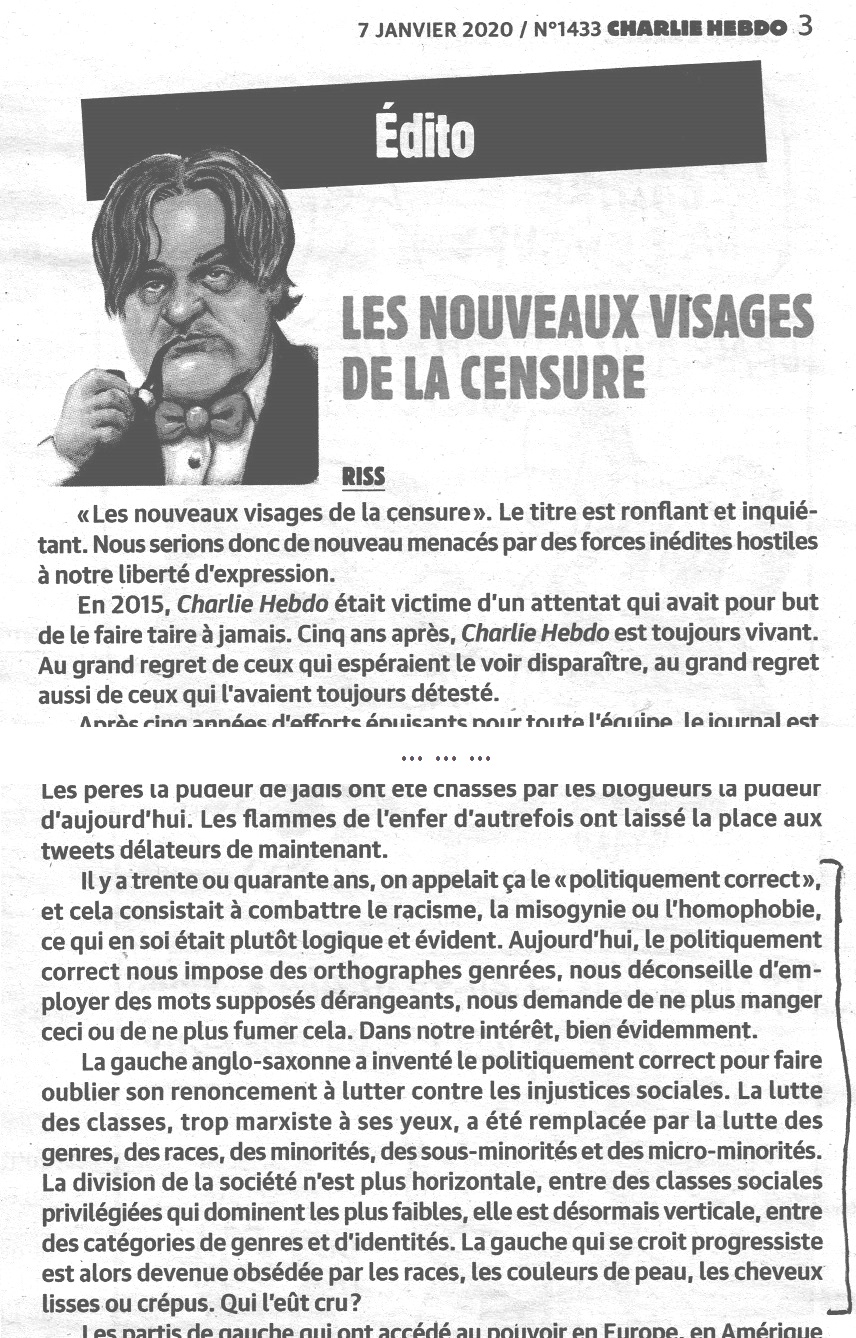
Returning to the degeneration of the political left, the opinion of Riss, editorialist for the satirical magazine Charlie Hebdo, is enlightening. The primary viewpoint of Charlie Hebdo is atheist and secularist, so what it says is often worth looking at. Writing in the January 7th 2020 issue, marking the fifth anniversary of that horrific massacre we all remember, Riss criticizes what he calls the “Anglo-Saxon left” for corrupting the concept of political correctness which used to be progressive but has now become fashionable nonsense, an obsession with trivialities and a tool for self-righteous moralizing.
Is Riss right to blame the Anglo left? Well not completely, but largely, yes. Postmodernist philosophy which is one of the influences in the degeneration of the left is largely of French origin. However intersectionality is, to the best of my knowledge, an American product, with a significant contribution from Concordia University in Montreal. Islamoleftism is a product of both British and French Marxists and perhaps others, mainly Trotskyists I believe. Multiculturalism is very much an Anglo-Canadian obsession. So Riss is at least partly right. Furthermore, the current unhealthy stew of regressive pseudo-progressive tendencies radiates mainly from the Anglo-American-Canadian sphere and is a major threat to secularism in France, in Quebec and everywhere.
But whatever its origins, the toxic influence of the anti-Enlightenment pseudo-left must be denounced and combated.
SLIDE: “Strategies of Political Islam”
As I have explained, the two most important opponents of secularism and Bill 21 are political Islam and the regressive pseudo-left. I have already discussed the latter. We need to look at the former.
By my definition, a supporter of Islamism or political Islam is anyone who promotes Islam politically, who attempts to influence government or the State by injecting Islam into it in some way, by granting privileges of some sort. Forget terrorism, for now at least, that is only the most extreme strategy of Islamism and is fortunately very rare. Proponents of political Islam have found much easier and more cost-effective strategies. Here are some of them:
- Promotion of the veil.
- Legal jihad, using the language of human rights to fight against human rights, e.g. Zunera Ishaq, Hak versus Bill 21.
- Rhetoric of inversion, i.e. victim-playing.
- Accusations of “Islamophobia” = the blasphemy of the 21st century, social censorship rather than legal (as described in Riss’ editorial “The New Faces of Censorship”.)
- Conflating race and religion (with the complicity of multiculturalists and regressive pseudo-leftists), in order to rationalize accusations of “racism” against anyone who criticizes Islam. This confusion amounts to a denial of freedom of conscience. It is the soft form of the Islamic condemnation of apostasy.
The convergence of the last two strategies is very effective and dangerous. The accusation of “Islamophobia” confuses ideas (Islam) with people (Muslims) while the conflation of race and religion confuses innate properties (genetics) with acquired properties (opinions, beliefs). Both of these amount to a denial of freedom of conscience: Religious believers are treated as prisoners of the religion in which they were born. Islamists love this. They want to do for Islam what has already unfortunately occurred for Judaism: erase the necessary distinction between the religion and the ethnicity.
SLIDE: “Islamist Veil: Its Significance”
I call it the Islamist veil, not just the Islamic veil, because it is a tool of political Islam.
- The Islamist veil, in all its forms, is an advertisement for political Islam, regardless of the mentality of the woman wearing it.
- The Islamist veil is imposed by fanatics. It is not an article of clothing for Muslim women in general—but Islamists would like us to think that it is!
- Most women who wear the Islamist veil, especially in Muslim-majority countries, do so because they are in some sense forced to do so, as they are under severe pressure from family, community, fundamentalists and sometimes the law. The consequences of not wearing it can be life-threatening. The veil was previously rare in Muslim countries, now much more widespread.
- Those women who decide to wear the Islamist veil willingly, mainly in non-Muslim countries, are implicitly expressing solidarity with political Islam, whether or not they are conscious of the implications of their decision. Such women are objectively allied with religious fanaticism.
- The Islamist veil is a marker of segregation, keeping Muslims separate from other “inferior” people. It also sends the message that religious affiliation (for Muslims) is more important than other attributes.
- The Islamist veil is a purity symbol, a form of slut-shaming. Wearing it means that other women who do not wear it, especially Muslim women who do not wear it, are impure, i.e. “easy.”
- The Islamist veil is an expression of rape culture. It implies that women are responsible for the sexual excesses of heterosexual men.
- The Islamist veil is not just an article of clothing. To treat is as such is to empower the religious fanatics who use it for proselytism and propaganda.
- The Islamist veil is a tool to control women’s bodies.
To summarize, proponents of political Islam use veiled women in the same way that dogs use their urine: to mark their territory.
SLIDE: “Islamist Veil: It’s About “Purity””


The veil is systematic slut-shaming, objectification of women, sexual segregation and religious segregation. Regardless of the mentality of the individual hijabi.
SLIDE: “Islamist Veil: A Rational Response”
How should we respond rationally to the presence of the hijab and other variants of the Islamist veil as they proliferate in society? The answer is obvious given the extremely retrograde nature of the veil.
- Discourage its use everywhere. We certainly should not celebrate it as the Canadian government and its institutions stupidly do.
- Ban it (and all religious symbols) where appropriate. The appropriate place is on the job in civil service position. Private corporations (larger than a certain minimum number of employees) should also be able to ban religious symbols on the job, but only if they apply the ban to all religions.
- Condemn harassment of anyone who wears religious symbols where they are not banned. The point of bans in some places and not others is to maximize freedom, so where symbols are not banned, the personal freedom of the wearer takes precedence. Furthermore, we cannot in general know why any individual wears a hijab or other symbol. She may be forced by others.
- Ban long-term veiling of children in schools (and perhaps elsewhere) because it is a form of child abuse. For a little girl, the hijab or niqab, etc. is more than just a religious symbol. It is a threat to her physical and emotional health and a serious impediment to socialization. Over an extended period (weeks, months, years) it compromises her ability to play and exercise, it may lead to vitamin D deficiency, it is a form of religious and sexual segregation and religious branding which interferes with her interactions with other children. If it lasts for years, it robs her of her childhood.
- Ban versions of the veil which obscure the face (niqab and burqa), like all face-coverings, for users of civic services (including of course citizenship ceremonies) and in any situation where covering the face compromises security, identification or communication. This includes at least situations where security checks are performed, such as in airports or at entrances to some public buildings. The niqab and burqa are more than just religious symbols. They are barbaric, representing a violation of human dignity and women’s rights. Extending this ban to everywhere in public is an option to be considered.
SLIDE: “The Insanity of Islamolatry”
Literally, the word “Islamolatry” means worship or adoration of Islam (not to be confused with actually practising Islam). I use the term to indicate the pernicious habit of giving preferential treatment to one religion, Islam, by absolving it of all criticism.. It is one of the major problems with the anti-Enlightenment pseudo-left. Here are some examples:
 Endorsing Child Abuse by veiling children: CHRC Endorses Religious Child Abuse [18] and Paediatrics & Child Health [19]
Endorsing Child Abuse by veiling children: CHRC Endorses Religious Child Abuse [18] and Paediatrics & Child Health [19] LGBT Community Day and Parade, Montreal 2016 [20]. We were scolded because of our slogan “HOMOPHOBIA, VIRUS PROPAGATED BY RELIGIONS,” because “some gays who are Muslim.”
LGBT Community Day and Parade, Montreal 2016 [20]. We were scolded because of our slogan “HOMOPHOBIA, VIRUS PROPAGATED BY RELIGIONS,” because “some gays who are Muslim.”- LGBT Parade, Montréal 2018 [21]. Young man, on his way to a leftist contingent in the march, sees our poster and says “That’s what the fascists say.”
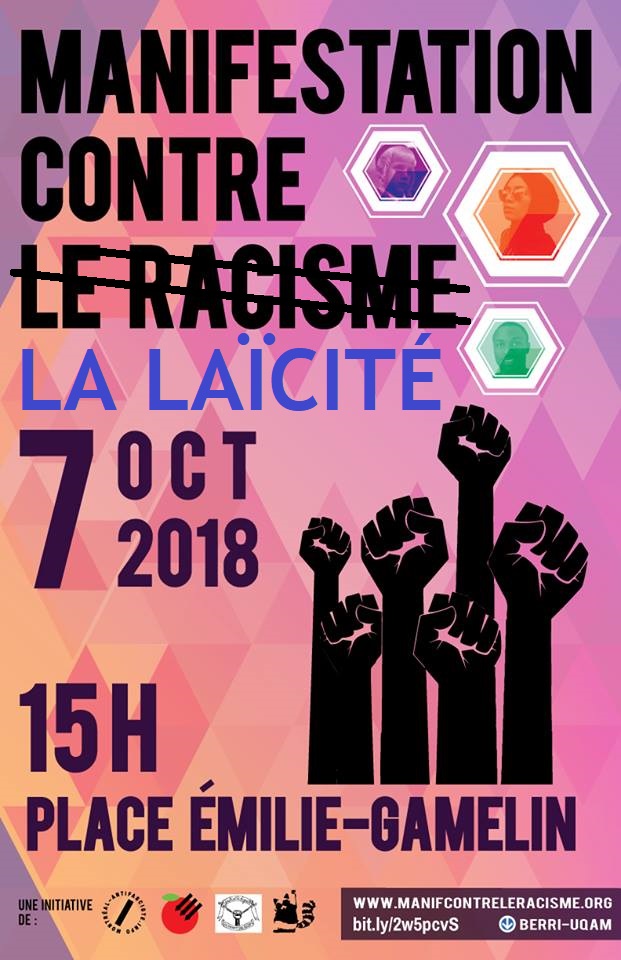 March against “racism” [22], in Montreal, 2018-10-07, was in fact a march against secularism, taking place only days after the new CAQ government was elected and announced its intention to pass a secularism law.
March against “racism” [22], in Montreal, 2018-10-07, was in fact a march against secularism, taking place only days after the new CAQ government was elected and announced its intention to pass a secularism law.- Black Lives Matter Toronto demands “End Islamophobia & White Supremacy” [23]! Not only is this an unacceptable conflation of race with religion, it also spreads the falsehood that anti-Muslim prejudice is somehow necessarily related to white supremacy (not in Quebec City).
The so-called “anti-racism” movement of the 21st century is intellectually bankrupt. It has been utterly corrupted ideologically and has ZERO credibility. It has become a vehicle for Islamist propaganda, conflating race and religion, vilifying secularists. It is itself racist, or perhaps racialist is a better term, seeing people principally in terms of 19th century racial categories such as “black,” “white,” etc. It declares “race” to be non-existent, then persists in assigning everyone to a race while attaching great significance to that racial identity. It is entirely dominated by the American experience of racism, i.e. an overwhelming emphasis on anti-black racism, while ignoring the reality of anti-Québécois racism which is a major aspect of Canadian history.
SLIDE: “Attitudes towards religious symbols & accommodation in Quebec”
A recent study (March 2018) published in the periodical Politics and Religion found a distinction between those in Quebec who would restrict all religious symbols and those who would restrict only minority religious symbols. The former showed liberal values and low religiosity, whereas the latter showed prejudice.
Similarly, a study published a few months later in Nations and Nationalism, Journal of the Association for the Study of Ethnicity and Nationalism, found that opposition to religious accommodation in Quebec is rooted more in low religiosity than in “racial animus.”
In other word, the high popularity of Bill 21 — a law which restricts all religious symbols and rejects religious accommodation — is related more to low religiosity, not racism, in Quebec.
SLIDE: “Summing Up”
According to a recent Léger poll [24], some 38% of Canadians outside Quebec support banning religious symbols for civil servants in positions of authority, like Bill 21. When Quebec is included in the poll, the percentage rises to 44%, slightly exceeding the 43% who oppose such a ban. But you would not expect this given the outrageous and hysterical reaction of both mainstream media and mainstream political leaders in English Canada, who vilify and misrepresent the Bill. Clearly, Canadians are more progressive than the anti-secular media and politicians who scream the loudest.
If those Anglo-Canadians who call themselves secularists took the word “multiculturalism” literally and seriously in its generic sense, as meaning openness to other cultures (which is what they claim it means), then they would apply that principle to secularism and consider the implementations in various countries both in and outside of the English-speaking world. They would look in particular at the secular traditions in the English- and French-speaking worlds, evaluate them and take the best from each. It is obvious to me that, whether by historical accident or by design, the French implementation is clearly superior to the Lockean English model. But even if you disagree with me, you must at least respect the democratic decision of Quebeckers to adopt the model which they strongly prefer.
But of course, in practice, “multiculturalism” does not mean openness to other cultures. It is an ideology which assigns greater importance to what divides us (such as religion) than to what unites us, which dogmatically promotes religious privilege and which is imposed monolithically, in the attempt to force everyone into the same mindset. “Multiculturalism” is, ironically, a monoculture. If you disagree with it, you are vilified as intolerant, racist, or worse.
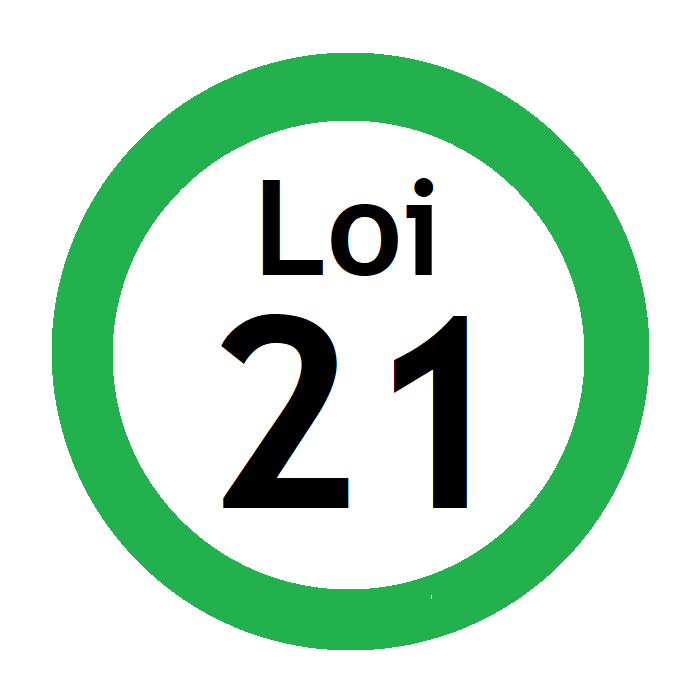
Rather than respecting Quebec’s decision to implement secularism, most so-called secularists in Canada outside Quebec, or at least the most vocal ones, have chosen to react to that decision with the very xenophobia of which they falsely accuse Quebeckers. The hypocrisy of these pseudo-secularists is obvious and shameful.
Humanist Canada is faced with a choice:
- Continue to do the popular and fashionable thing: continue to throw Quebec secularists under the bus by opposing Bill 21 or waffling on the issue.
- Or do the right thing: support secularism and support Bill 21.
Article printed from Atheist Freethinkers: https://www.atheology.ca
URL to article: https://www.atheology.ca/special/2020-02-09-webinar-bill-21-for-hc/
URLs in this post:
[1] the corresponding slide presentation: https://www.atheology.ca/pdf/2020_02_09_hc_webinar_SLIDES.pdf
[2] video of this presentation: https://www.youtube.com/playlist?list=PLNDGb4UVQI8zWDb5VW9A1I3PG-RcOTSwl
[3] our Youtube channel: https://www.youtube.com/user/lpaaft
[4] Bill 21 in English: http://www2.publicationsduquebec.gouv.qc.ca/dynamicSearch/telecharge.php?type=5&file=2019C12A.PDF
[5] Bill 21 in French: http://www2.publicationsduquebec.gouv.qc.ca/dynamicSearch/telecharge.php?type=5&file=2019C12F.PDF
[6] The fiscal problem: https://www.atheology.ca/blog-110/
[7] Public Services Act: http://legisquebec.gouv.qc.ca/en/ShowDoc/cs/F-3.1.1
[8] anti-tobacco legislation: https://blog.davidrand.ca/tobacco-politics-religion/
[9] a recent article in Le Devoir: https://www.ledevoir.com/opinion/idees/571562/gerard-bouchard-et-la-denaturation-de-la-laicite
[10] argues eloquently for extending secularism to hospitals: https://blog.davidrand.ca/for-secularism-hospitals/
[11] Writing in the Journal of Medical Ethics in 2006: https://www.ncbi.nlm.nih.gov/pmc/articles/PMC2563267/
[12] Laïcité et tolérance: https://www.franceculture.fr/emissions/repliques/laicite-et-tolerance
[13] The niqab in citizenship ceremonies: https://blog.davidrand.ca/extended-weinberg-principle/
[14] Gerald Caplan’s obscene defamation of anyone who opposed it: https://www.theglobeandmail.com/news/politics/i-endorsed-mulcair-for-ndp-leader-but-i-have-little-enthusiasm-left/article28768580/
[15] AFT press release: https://www.atheology.ca/press-releases/2018-02-02/
[16] Council of Ex-Muslims of Britain: https://www.ex-muslim.org.uk/
[17] 2019 poll: https://www.atheology.ca/statistics/ifop-2019-03-22-french-secularism/
[18] CHRC Endorses Religious Child Abuse: https://blog.davidrand.ca/chrc-endorses-religious-child-abuse/
[19] Paediatrics & Child Health: https://blog.davidrand.ca/this-does-not-promote-child-health/
[20] LGBT Community Day and Parade, Montreal 2016: https://www.atheology.ca/blog-075/
[21] LGBT Parade, Montréal 2018: https://www.atheology.ca/blog-101/
[22] March against “racism”: https://blog.davidrand.ca/moral-intellectual-bankruptcy-antisecularists/
[23] Black Lives Matter Toronto demands “End Islamophobia & White Supremacy”: https://blacklivesmatter.ca/demands/
[24] a recent Léger poll: https://www.atheology.ca/statistics/leger-2019-09-16-canadians-secularism-bill-21/
[25] : https://www.facebook.com/sharer/sharer.php?u=https%3A%2F%2Fwww.atheology.ca%2Fspecial%2F2020-02-09-webinar-bill-21-for-hc%2F
[26] : http://twitter.com/intent/tweet?text=2020-02-09%3A%20Webinar%20on%20Bill%2021%20For%20%3Cem%3EHumanist%20Canada%3C%2Fem%3E&url=https%3A%2F%2Fwww.atheology.ca%2Fspecial%2F2020-02-09-webinar-bill-21-for-hc%2F
Click here to print.

